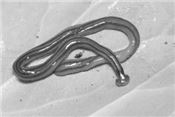Hammerhead Sightings On The Rise; Experts Say Not To Worry

Hammerhead worm sightings have been on the rise throughout Arkansas.
Division of Agriculture photo
RYAN MCGEENEY
LITTLE ROCK, ARKANSAS
Yes, they’re weird. They’re invasive. And if you go about it the wrong way, your efforts to rid your lawn of them will only multiply your woes.
But the hammerhead worm – a blanket term for a complex of species known among scientists as planarians, or terrestrial flatworms – isn’t here to hurt you, although it may pose a threat to native worm species.
Hammerheads gained a degree of notoriety last summer as an increasing number of gardeners and homeowners connected via social media, sharing smartphone pics of the odd creatures. Jon Zawislak, assistant professor of apiculture and urban entomology for the University of Arkansas System Division of Agriculture, said that increased awareness and connectivity are primarily responsible for the seemingly sudden “wormageddon.”
“They’ve been reported from all over the place for the last couple of years,” Zawislak said. “There does seem to be an uptick in the reports lately, but I think that’s because people are aware of them now. Nothing’s really changed about the pest since last year.”
Nevertheless, one could be forgiven for feeling like the worms are closing in. In June, Greene County extension agent Lance Blythe posted a brief social media explainer on the worms, which drew about half a million views, he said.
“Our administrative assistant has been keeping up with the comments,” Blythe said. “We’re not getting a lot of feedback in Greene County, per se, but from other places in the state, mostly south of Interstate 40.
“It’s nothing to be alarmed about, just something to be aware of,” he said. “We just let folks know what it is, and how to deal with it if they come across one.”
While the worms are not especially harmful to touch, they do issue a toxin that irritates the eyes and mouth, so individuals are cautioned to wear gloves if available.
“When homeowners find them in their yard, we recommend they kill them, just so that individual worm doesn’t reproduce,” Zawislak said. The most effective way of killing hammerhead worms is to put it in a freezer bag containing salt and vinegar and freeze it over night before disposing of it in a waste receptacle.
Do not, however, attempt to kill it by cutting it in half.
“Then you just have two active worms,” Zawislak said.
While there is currently no scientific survey establishing population numbers for hammerhead worms, “citizen scientists” are helping to establish generalized maps of where any number of species have been sighted throughout the world.
Homeowners who discover hammerhead worms do not need to contact their local extension offices — some agents have been inundated with calls about the worms, and it’s unnecessary.
“I’ve encouraged people to use www.iNaturalist.org,” Zawislak said. “It’s a citizen science project that’s attempting to catalogue all living things — plants, animals, all of it. If you see a bird, a fish, anything, snap a picture of it on your smartphone and upload it using the app. “You can look at the distribution of any species.
“That tool is going to be better for tracking an invasive species than anything any agency has right now,” he said. ∆
RYAN MCGEENEY: University of Arkansas